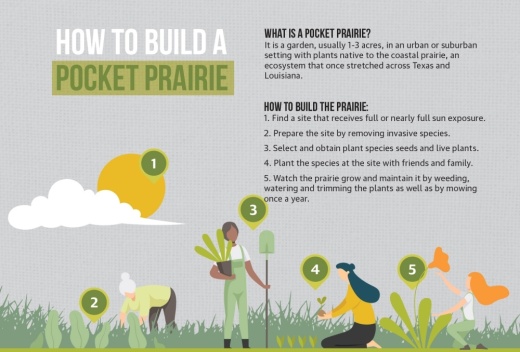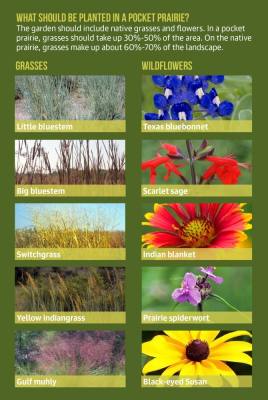What is a pocket prairie?
It is a garden, usually 1-3 acres, in an urban or suburban setting with plants native to the coastal prairie, an ecosystem that once stretched across Texas and Louisiana.
How to build the pocket prairie:
- Find a site that receives full or nearly full sun exposure.
- Prepare the site by removing invasive species.
- Select and obtain plant species seeds and live plants.
- Plant the species at the site with friends and family.
- Watch the prairie grow and maintain it by weeding, watering and trimming the plants as well as by mowing once a year.
The garden should include native grasses and flowers. In a pocket prairie, grasses should take up 30%-50% of the area. On the native prairie, grasses make up about 60%-70% of the landscape. Check out the infographics above for examples of grasses and flowers to plan.
Where can I visit a pocket prairie?
There are six pocket prairies in the Katy area at local schools, but there are dozens more across the Greater Houston area.
- Katy High School, 6331 Highway Blvd., Katy
- Katy Elementary School, 5726 George Bush Ave., Katy
- Michael L. Griffin Elementary School, 7800 S. Fry Road, Katy
- Roosevelt Alexander Elementary School, 6161 S. Fry Road, Katy
- Montessori House for Children, 20625 Lakemont Bend Lane, Richmond
- Tom Wilson Elementary School, 5200 Falcon Landing Blvd., Katy
Want to learn more?
Check out the following resources:
- Katy Prairie Conservancy: www.katyprairie.org/buildpocketprairies
- Native Plant Society of Texas–Houston Chapter: https://npsot.org/wp/houston/
- Houston Arboretum & Nature Center: www.houstonarboretum.org
- Lady Bird Johnson Wildflower Center: www.wildflower.org/magazine/native-plants/make-pocket-prairie






